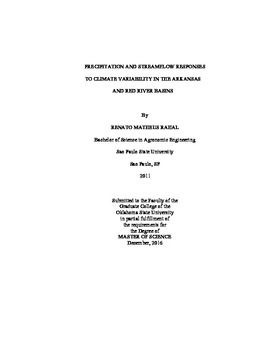| dc.contributor.advisor | Zou, Chris | |
| dc.contributor.author | Matheus Rahal, Renato | |
| dc.date.accessioned | 2018-06-29T14:41:04Z | |
| dc.date.available | 2018-06-29T14:41:04Z | |
| dc.date.issued | 2016-12-01 | |
| dc.identifier.uri | https://hdl.handle.net/11244/300361 | |
| dc.description.abstract | The Arkansas-Red River Basin (ARRB) features a steep east-west precipitation gradient ranging from 380 to 1420 mm. The objective of this study is to understand how precipitation (P) in different parts of the ARRB basin is connected to large-scale climate phenomena, mainly the Pacific Decadal Oscillation (PDO) and how streamflow (Q) responses to P differ in different phases of the PDO. Annual total P from 1932 to 2014 was significantly correlated with the PDO in all watersheds in the western and three watersheds in the central part of the basin (p 0.05). On average, annual Q variability in the basin was high, with coefficient of variation of 0.72. The streamflow coefficient (Q/P) was 0.07, 0.14 and 0.29 in the western, central and eastern parts of the basin, respectively, meaning that 7, 14 and 29% of P translated to Q. During positive phase of the PDO, the western and central parts of the basin experienced the largest increase in annual P and Q. From negative to positive PDO, annual total P increased by 20.5 and 16.6% while Q increased by 50.4 and 52% in the western and central parts of the basin, respectively. Seasonally, P increased the most during winter for the western part of the basin and during spring for the central part. Also in the central and western parts of the ARRB, Q increased significantly in all seasons during positive PDO. Q increased by up to 53% during fall in the western part of the basin and up to 80% during winter in the central part of the basin. Grazing systems, such as winter wheat grazing can be managed to take advantage of the increased foraging production potential during positive PDO phase. Farmers, ranchers and farm insurance agents can also benefit from the knowledge of potential droughts associated with the negative phases of the PDO by planting drought resistant crops or reducing herd size and purchasing drought insurance. Finally, municipal utility authorities can make more effective middle and long range planning by considering the water availability during the positive and negative phases of PDO. | |
| dc.format | application/pdf | |
| dc.language | en_US | |
| dc.rights | Copyright is held by the author who has granted the Oklahoma State University Library the non-exclusive right to share this material in its institutional repository. Contact Digital Library Services at lib-dls@okstate.edu or 405-744-9161 for the permission policy on the use, reproduction or distribution of this material. | |
| dc.title | Precipitation and Streamflow Responses to Climate Variability in the Arkansas and Red River Basins | |
| dc.contributor.committeeMember | Fox, Garey | |
| dc.contributor.committeeMember | Ochsner, Tyson E. | |
| osu.filename | MatheusRahal_okstate_0664M_14925.pdf | |
| osu.accesstype | Open Access | |
| dc.description.department | Natural Resources and Ecology Management | |
| dc.type.genre | Thesis | |
| dc.type.material | text | |
